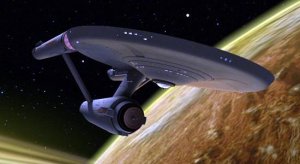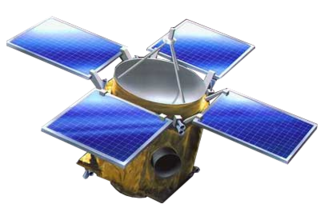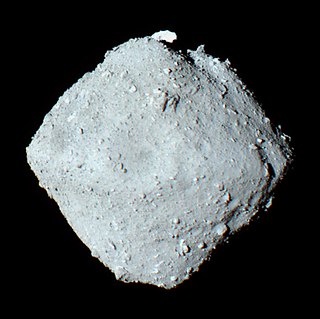Related Research Articles

An asteroid is a minor planet of the inner Solar System. Sizes and shapes of asteroids vary significantly, ranging from 1-meter rocks to dwarf planets almost 1000 km in diameter; they are metallic or rocky bodies with no atmosphere.

Deep Space 1 (DS1) was a NASA technology demonstration spacecraft which flew by an asteroid and a comet. It was part of the New Millennium Program, dedicated to testing advanced technologies.

Enterprise or USS Enterprise is the name of several fictional spacecraft, some of which are the main craft and setting for various television series and films in the Star Trek science fiction franchise. The most notable were Captain James T. Kirk's USS Enterprise (NCC-1701) from the original 1960s television series, and Captain Jean-Luc Picard's USS Enterprise (NCC-1701-D) from Star Trek: The Next Generation.

Near Earth Asteroid Rendezvous – Shoemaker, renamed after its 1996 launch in honor of planetary scientist Eugene Shoemaker, was a robotic space probe designed by the Johns Hopkins University Applied Physics Laboratory for NASA to study the near-Earth asteroid Eros from close orbit over a period of a year. It was the first spacecraft to successfully orbit an asteroid and also land on an asteroid. In February 2000, the mission succeeded in closing in with the asteroid and afterwards orbited it several times. On February 12, 2001, the mission succeeded in touching down on the asteroid. It was terminated just over two weeks later.

A spacecraft is a vehicle or machine designed to fly in outer space. A type of artificial satellite, spacecraft are used for a variety of purposes, including communications, Earth observation, meteorology, navigation, space colonization, planetary exploration, and transportation of humans and cargo. All spacecraft except single-stage-to-orbit vehicles cannot get into space on their own, and require a launch vehicle.

Spaceflight is an application of astronautics to fly spacecraft into or through outer space, either with or without humans on board. Most spaceflight is uncrewed and conducted mainly with spacecraft such as satellites in orbit around Earth, but also includes space probes for flights beyond Earth orbit. Such spaceflight operates either by telerobotic or autonomous control. The more complex human spaceflight has been pursued soon after the first orbital satellites and has reached the Moon and permanent human presence in space around Earth, particularly with the use of space stations. Human spaceflight programs include the Soyuz, Shenzhou, the past Apollo Moon landing and the Space Shuttle programs, with currently the International Space Station as the main destination of human spaceflight missions while China's Tiangong Space Station is under construction.

Clementine was a joint space project between the Ballistic Missile Defense Organization and NASA, launched on January 25, 1994. Its objective was to test sensors and spacecraft components in long-term exposure to space and to make scientific observations of both the Moon and the near-Earth asteroid 1620 Geographos.

Surveyor 6 was the sixth lunar lander of the American uncrewed Surveyor program that reached the surface of the Moon. Surveyor 6 landed on the Sinus Medii. A total of 30,027 images were transmitted to Earth.
Multiple dispatch or multimethods is a feature of some programming languages in which a function or method can be dynamically dispatched based on the run-time (dynamic) type or, in the more general case, some other attribute of more than one of its arguments. This is a generalization of single-dispatch polymorphism where a function or method call is dynamically dispatched based on the derived type of the object on which the method has been called. Multiple dispatch routes the dynamic dispatch to the implementing function or method using the combined characteristics of one or more arguments.
In programming language theory and type theory, polymorphism is the provision of a single interface to entities of different types or the use of a single symbol to represent multiple different types. The concept is borrowed from a principle in biology where an organism or species can have many different forms or stages.

The B612 Foundation is a private nonprofit foundation headquartered in Mill Valley, California, United States, dedicated to planetary science and planetary defense against asteroids and other near-Earth object (NEO) impacts. It is led mainly by scientists, former astronauts and engineers from the Institute for Advanced Study, Southwest Research Institute, Stanford University, NASA and the space industry.

Celestia is a 3D astronomy software program created by Chris Laurel. The program allows users to virtually travel through a simulated version of our universe. Celestia can display objects of various scales using OpenGL.

USS Enterprise (NCC-1701) is a fictional starship in the Star Trek media franchise. It is the main setting of the original Star Trek television series (1966–69), and it is depicted in films, other television series, spin-off fiction, products, and fan-created media. Under the command of Captain James T. Kirk, the Enterprise carries its crew on a mission "to explore strange, new worlds; to seek out new life and new civilizations; to boldly go where no man has gone before." The 2022 series Star Trek: Strange New Worlds depicts the Enterprise under the command of Kirk's predecessor, Captain Christopher Pike.

Hayabusa2 is an asteroid sample-return mission operated by the Japanese state space agency JAXA. It is a successor to the Hayabusa mission, which returned asteroid samples for the first time in June 2010. Hayabusa2 was launched on 3 December 2014 and rendezvoused in space with near-Earth asteroid 162173 Ryugu on 27 June 2018. It surveyed the asteroid for a year and a half and took samples. It left the asteroid in November 2019 and returned the samples to Earth on 5 December 2020 UTC. Its mission has now been extended through at least 2031, when it will rendezvous with the small, rapidly-rotating asteroid 1998 KY26.

Spacecraft magnetometers are magnetometers used aboard spacecraft and satellites, mostly for scientific investigations, plus attitude sensing. Magnetometers are among the most widely used scientific instruments in exploratory and observation satellites. These instruments were instrumental in mapping the Van Allen radiation belts around Earth after its discovery by Explorer 1, and have detailed the magnetic fields of the Earth, Moon, Sun, Mars, Venus and other planets and moons. There are ongoing missions using magnetometers, including attempts to define the shape and activity of Saturn's core.

Space architecture is the theory and practice of designing and building inhabited environments in outer space. This mission statement for space architecture was developed at the World Space Congress in Houston in 2002 by members of the Technical Aerospace Architecture Subcommittee of the American Institute of Aeronautics and Astronautics (AIAA). The architectural approach to spacecraft design addresses the total built environment. It is mainly based on the field of engineering, but also involves diverse disciplines such as physiology, psychology, and sociology.

162173 Ryugu, provisional designation 1999 JU3, is a near-Earth object and a potentially hazardous asteroid of the Apollo group. It measures approximately 1 kilometre (0.62 mi) in diameter and is a dark object of the rare spectral type Cb, with qualities of both a C-type asteroid and a B-type asteroid. In June 2018, the Japanese spacecraft Hayabusa2 arrived at the asteroid. After making measurements and taking samples, Hayabusa2 left Ryugu for Earth in November 2019 and returned the sample capsule to Earth on 5 December 2020.
The space-opera blockbuster Star Wars franchise has borrowed many real-life scientific and technological concepts in its settings. In turn, Star Wars has depicted, inspired, and influenced several futuristic technologies, some of which are in existence and others under development. In the introduction of the Return of the Jedi novelization, George Lucas wrote: "Star Wars is also very much concerned with the tension between humanity and technology, an issue which, for me, dates back even to my first films. In Jedi, the theme remains the same, as the simplest of natural forces brought down the seemingly invincible weapons of the evil Empire."

Hera is a space mission in development at the European Space Agency in its Space Safety program, which objective is to contribute to validate the kinetic impact method to possibly deviate a near-Earth asteroid in a colliding trajectory with Earth. It will measure the size and the morphology of the crater and momentum transmitted by an artificial projectile during an impact on an asteroid, which will allow measuring the efficiency of the deflection produced by the impact. This being a test, the asteroid and the deflection test have been chosen in order not to pose any risk, whatever the result. Furthermore, the mission will fully characterise the composition and physical properties of a binary asteroid, including, for the first time, the sub-surface and internal structures. It will also perform technological demonstrations linked to operations in the vicinity of a small body and the deployment and the communication with CubeSats in interplanetary space.
References
- ↑ A Simple Technique for Handling Multiple Polymorphism. In Proceedings of OOPSLA '86, Object–Oriented Programming Systems, Languages and Applications, pages 347–349, November 1986. Printed as SIGPLAN Notices, 21(11). ISBN 0-89791-204-7
- ↑ More Effective C++ by Scott Meyers(Addison-Wesley, 1996)
- ↑ "Using Type dynamic (C# Programming Guide)". Microsoft Developer Network. Microsoft. 30 Sep 2009. Retrieved 25 May 2016.
... Overload resolution occurs at run time instead of at compile time if one or more of the arguments in a method call have the type dynamic ...
This article needs additional citations for verification .(August 2008) |